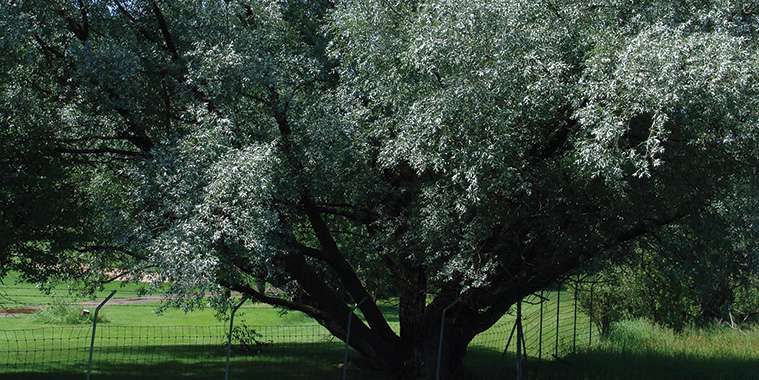by Dorothy Dobbie
What is more glamorous in the plant world than to see graceful weeping willow branches sweeping the surface of a still pond?
Weeping willow loves moist, well-draining soil so it haunts the margins of waterways when she can; most willows enjoy a heavy diet of fluids and do best where the earth is wet.
Many willows will put out roots at every opportunity. All you have to do is tuck a cutting (or even a stick) in some soil and it will try to root itself wherever the wood touches the ground. Weeping willows, pussy willows and even curly willows, used in ornamental bouquets will do this and often will send out roots in the bouquet water.
There are a lot of willow varieties as the tree is native to the northern hemisphere. Among the prettiest of willows is Salix integra ‘Hkuro Nishiki’, also known as dappled willow, a Japanese variety that has variegated leaves of white and cream, with green freckles. New growth is pink. This shrub grows four to six feet tall in fertile, well-drained soil and prefers sun to get the best colour, although it will do better with a bit of afternoon shade in very hot climates.
Another variety that we love is the pussy willow, Salix discolor, the North American variety that produces the velvety white flowers we all enjoy in the early spring. The plants are dioecious, meaning it takes two to tango – a male plant and a female plant. The male flowers turn yellow with pollen when mature. Be careful not to buy the European pussy willow or goat willow, Salix caprea – the female flowers turn green at maturity while the males also get covered with yellow pollen.
Pussy willows provide early sustenance to pollen loving bees, but the pussies on the willow can also be mashed and eaten if you happen to be lost in the wilderness sometime in the future. By the way, young willow leaves contain about seven times more vitamin C than an orange.
There is a small shrub common on the prairies called wolf willow, but it is not a willow at all. This is Elaeagnus commutate, pretty little shrub also known as silver berry. There is however, a shrub called coyote willow, Salix exigua, which reaches up to 23 feet whose leaves are also grey-green, at least when the leaves are young. It is can be found growing wild along streams and lakes.
A beautiful silver leafed willow growing 50 feet tall and wide, is the silver willow, Salix alba ‘Sericea’, which is hardy to zone 2. It is multi-stemmed and grows quickly. Ideal for shelterbelts or large spaces, it will live at least 80 years. It can be invasive, so be sure you have the space to accommodate this lovely tree.
A very common willow is Salix amygdaloides, the peachleaf willow, which is the second only to the cottonwood in size on the prairies, although it grows from Quebec to western British Columbia. It will grow to 66 feet tall and often has a single trunk. The leaves are yellowish green with a pale underside. This willow grows only from seeds and it has a limited life span of 25 to 50 years.
This is just a quick glimpse into the wonderful world of willows, of which there are 400 species to choose from. Willow responds extremely well to pollarding, sending out long straight branches (withies) that have been used in a myriad of ways, including as fodder for cattle. It is an extremely useful plant having been favoured for basket making, home building (wattle huts) and even boat making (Welsh coracles) in the past. And of course, willow was the first “aspirin” thanks to the properties of its salicin. It was only displaced back in 1897, when Felix Hoffman discovered how to synthesize the acetylsalicylic acid in a version derived from Spiraea ulmaria. He worked for Bayer which named to new drug aspirin. Willow is also being used in Australia as bio-fuel.
Dorothy Dobbie is the founder of Manitoba Gardener magazine and the Local Gardener series. Visit us at localgardener.ca.



